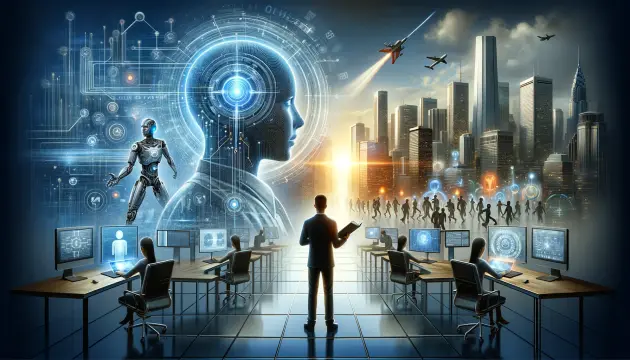Home
AI and Job Displacement: How the U.S. Economy Is Adapting
March 1, 2025
As AI advances, job displacement concerns grow. However, the U.S. economy is adapting by fostering new opportunities, reskilling programs, and AI-driven industries.

Artificial intelligence (AI) is transforming the workforce, automating processes, and enhancing efficiency. However, it is also reshaping employment patterns, raising concerns about job displacement. While certain jobs are being automated, new opportunities are emerging as the economy adapts. This article explores the impact of AI on job displacement, how industries are responding, government initiatives, and the future of work in the U.S.
The Impact of AI on Employment
AI-driven automation has significantly changed industries, from manufacturing to finance. Repetitive and routine tasks are increasingly performed by machines, reducing demand for human labor in these areas. Some of the most affected sectors include:
- Manufacturing: AI-powered robots handle assembly lines, reducing the need for manual labor.
- Retail: Self-checkout systems and AI-driven inventory management are replacing cashiers and stock workers.
- Customer Service: AI chatbots and virtual assistants are handling customer inquiries, reducing the need for call center agents.
- Transportation: The rise of autonomous vehicles threatens trucking and delivery jobs.
Despite these disruptions, AI is also generating new roles that require human oversight, creativity, and problem-solving skills.
New Job Opportunities Created by AI
While AI is displacing jobs, it is also creating opportunities in various fields, including:
- AI Development & Engineering: Companies are hiring software engineers, data scientists, and machine learning specialists to build and maintain AI systems.
- Cybersecurity & Data Protection: With AI-driven automation comes the need for stronger cybersecurity measures to protect sensitive data.
- AI Ethics & Regulation: As AI grows, ethical concerns arise, leading to a demand for experts in AI policy, regulation, and compliance.
- Healthcare & Biotechnology: AI is revolutionizing healthcare, requiring professionals to manage AI-powered diagnostic tools and robotic-assisted surgeries.
- Human-AI Collaboration Roles: Many businesses are integrating AI to support human workers rather than replace them, leading to hybrid roles in various industries.
How the U.S. Economy Is Adapting
To address job displacement, the U.S. economy is shifting toward innovation, reskilling, and new policies to support workers affected by automation.
1. Reskilling and Upskilling Programs
Public and private initiatives are investing in retraining workers for AI-related jobs. Examples include:
- Government Programs: The U.S. Department of Labor is funding workforce development programs focused on AI and emerging technologies.
- Corporate Training Initiatives: Companies like Amazon, Google, and Microsoft offer AI training programs to help employees transition into new roles.
- University Partnerships: Colleges and universities are creating AI-focused curriculums to prepare students for the evolving job market.
2. AI Regulation and Labor Policies
As AI reshapes employment, lawmakers are working to implement policies that protect workers and ensure fair labor practices. Recent policy discussions include:
- AI Transparency Laws: Requiring companies to disclose AI’s role in hiring and job decisions.
- Universal Basic Income (UBI): A debated concept to provide financial security for workers displaced by automation.
- Taxation of AI Automation: Some policymakers propose taxing companies that replace human jobs with AI to fund retraining programs.
3. Business Adaptation and Job Transformation
Many businesses are integrating AI while maintaining or even expanding their workforce by focusing on AI-human collaboration rather than full automation. For example:
- Retailers like Walmart and Target use AI to assist employees in managing inventory rather than eliminating jobs.
- Financial institutions employ AI to analyze data, while human analysts focus on strategic decision-making.
- Healthcare providers leverage AI to assist doctors with diagnostics rather than replacing them.
The Future of Work in the AI Era
The workforce of the future will require adaptability, continuous learning, and a focus on human-centric skills that AI cannot easily replicate. Key trends shaping the future include:
- Shift toward Tech-Integrated Jobs: AI will become a tool for enhancing human capabilities rather than a direct replacement.
- Greater Emphasis on Soft Skills: Creativity, critical thinking, emotional intelligence, and problem-solving will become essential.
- Hybrid Work Environments: Businesses will adopt models where AI supports employees in their roles, improving efficiency without total automation
